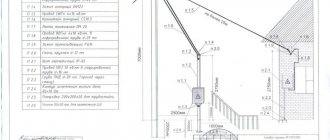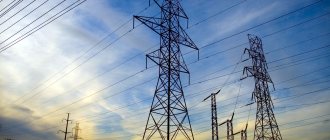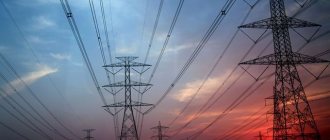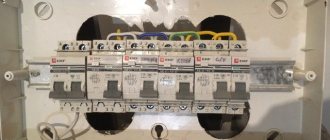After purchasing a home on the secondary real estate market, first of all, new owners, as a rule, change the wiring. In the process, it turns out that replacing the input circuit breaker is not so simple. If to install a model of the same type it is enough to call the electricians of the company providing the services, then to connect an AV with a large rated current, you need to submit an application so that the allocated electrical power is increased. Detailed information on this issue is provided below.
Getting a plan
As soon as the technical specifications are in your hands, you should begin developing a power supply project.
To increase the power to 15 kW, you need to order a document from one of the companies that are members of the SRO (self-regulatory organization), the professionals will do everything necessary themselves. Then you will have to contact the operator again to coordinate the received documentation. Only after this step can you begin to connect equipment to increase power to 15 kW. Again, we remind you that such operations can only be carried out by specialists. Doing this on your own is strictly prohibited! Another important point should be mentioned right away. When preparing a line project with similar indicators, you will not have to contact Rostechnadzor for additional approvals. This requirement applies only to situations where the connection is carried out by a legal entity, and the line power exceeds 15 kW
Please note that if you need a more powerful power supply, you may be required to contact two or three additional authorities at once. Therefore, experts advise not to exceed this threshold.
Upon completion of the work, the customer must receive a number of documents, which include:
- Papers on a cable line that was built to increase the power to 15 kW.
- Test protocol for installed cable.
- An inspection report of the trench or tunnel in which the cable was laid, with the corresponding diagram attached.
This completes the main work to increase power to 15 kW. All that remains is to coordinate the remaining documents, more on that later.
What it is
During capital construction during the USSR, for example in Khrushchev buildings, i.e. In most residential premises that are still in use today, even at the design stage the permitted power was up to 1.5 kW per apartment.
Later, the established electricity rate increased to 3 kW, as it became necessary to increase it due to the increased “gluttony” of consumers. Practice shows that 10-16 Ampere plugs were usually installed in electrical panels and meters, so that the maximum current consumed by an apartment was limited to a total electrical power of 3 kW for apartments with a gas stove. For apartments where an electric stove is installed, 7 kW is allocated. In new buildings, the allocated power can reach up to 15 kW. This scatter is due to the fact that during the construction of old houses (60s, 70s) there simply were not such powerful consumers and as many household appliances as there are now.
The allocated power is the maximum amount of electricity consumed at one point in time.
In addition, in order to enter the established limit, sometimes you need to enter not just 1 phase, as often happens, but as many as 3 phases. This is necessary for connecting modern household appliances, such as powerful electric boilers and electric stoves. This is especially true in commercial premises and industries of any scale, where a lot of electricity is needed (up to 30 kW and above).
Example. To heat a country house that is not equipped with gas equipment, solid fuel and electric boilers are installed, the latter are safer and more convenient. For heating a house with an area of 100 sq.m. you need a boiler with a power of about 7-10 kW, an electric stove consumes another 3-5 kW. In total, it is necessary to increase the established electricity limit to a minimum of 15 kW and supply electricity in three phases.
To find out the allocated power for a private house or apartment, you need to contact the operating organization (in Moscow and the region - this is Mosenergosbyt OJSC). The help contains information about the allocated and average power consumption. It will be needed if you are preparing documents for an increase; this will be discussed in detail below.
How many kilowatts do you need for a comfortable stay?
The required number of kilowatts for a home is calculated based on how many electrical appliances will be installed in the house. If we take into account the presence in the house of a minimum set of electrical appliances (lighting (150 W), refrigerator (500 W), microwave (1000 W), washing machine (2000 W), TV (200 W), computer (500 W), iron (1200 W) ), vacuum cleaner (1200 W), dishwasher (2000 W)), which in total consume 8750 W when switched on simultaneously, then the available 2-4 kW of electricity will not be enough.
Question and answer Where and how should electricity meters be placed in the country?
According to the set of rules SP 31-106-2002 “Design and construction of engineering systems of single-family residential buildings”, the load for a house is less than 60 square meters. m without electric stoves should be at least 5.5 kW, for a house with electric stoves - 8.8 kW. If the area of the house exceeds 60 sq. m, then the electricity load should be increased by 1% for each additional square meter of area. If the house uses electric heating and powerful air conditioners, 15 kW is enough.
What documents need to be collected
To obtain permission to connect to electrical networks you will need:
- Application. The standard form can be filled out at the company or home serving the energy network by downloading the document on the Internet.
- List of machines and devices that consume energy.
- Copies of documents confirming your rights as the owner of the house or plot.
- Land plan showing electrical lines.
- Site or building plan.
- A copy of the passport of the owner of the plot or the person drawing up documents under a power of attorney.
- Power of attorney if the documents are not drawn up by the owner of the property.
The application must be completed in two copies. One copy signed by the employee accepting the documents remains in the hands of the owner of the house or an authorized representative.
The form must indicate:
- Full name of the person who is preparing the documents. This could be the owner of the site or a trusted representative.
- Passport issue date, series and number. Or details of an identity document.
- The address where the person applying is registered.
- Name of devices that consume energy.
- Device connection times. For example, during construction, energy consumption may differ from when the facility is put into operation.
- Power of connected devices.
- The name of the organization with which you agree to enter into an energy supply contract.
- Construction permit. This document is attached if there is nothing on the site yet.
The application can be submitted not only in person. It is possible to accept documents by mail. Send two copies of the completed form, the copies listed above, and a list of all documents in the letter.
The easiest and fastest way to send documents is the Internet. Register on the website of the organization servicing power lines, fill out the form and send copies.
The network company must report errors in the submitted documents within 6 days. If everything is fine, the applicant is sent two copies of the agreement with signatures in paper form. Technical conditions (TS) are attached to the contract. The contract and specifications are prepared within 15 days.
Once you receive the contract, you need to sign it and send it to the company. Or use an electronic signature by completing all documents on the organization’s website.
Calculation of required power
To determine how much electricity you need, you need to add up the power of all consumers. For example:
- water heating tank (boiler) – 1-2 kW;
- refrigerator – 1 kW;
- air conditioner – 2.5 kW;
- Computer – 0.4 kW;
- Lighting – 0.1-1 kW;
- And etc.
This is called Pust - installed power, i.e. sum of kW of all consumers. In this case, more than 5 kW is already needed, which means that the allocated power of 3 kW is simply not enough. To reduce current consumption at the same power, it is worth switching to a 3-phase network. This will make it possible to distribute consumers into three phases. And a powerful load (more than 5 kW) cannot be connected in one phase, this is prohibited by the PUE (and a modern electric stove can consume 9 kW).
Important! Do not increase maximum power by replacing automatic transmissions or larger plugs. More than 25 Amps should not be used at home at all, unless the wiring is replaced with new ones (with the appropriate cable cross-section)
The circuit breaker protects the electrical wiring; if it does not operate on time, the wiring will begin to melt and a fire may occur. If you have replaced the wiring with a more powerful one (in houses and apartments above 2.5 mm2 they are rarely installed) - this is not a guarantee of reliable operation. In old apartments, a 2.5-4 mm2 aluminum wire comes from the panel. It can burn out easily.
In this case, you should take into account how many devices you turn on at the same time. There is such a thing as “power utilization factor”; for residential premises it is 0.8-0.9. The numbers may vary depending on how you use your electricity. In non-residential premises and in production, Usage tends to 1.
Total:
Pout=Kisp*Pust
Rules and regulations
Seal on the input machine
Electrification of residential, administrative, and industrial facilities is carried out on the basis of the technical specifications of the provider organization. One of the clauses of the contract specifies how much power will be allocated to the consumer network. The basis for declaring power and forming technical specifications are calculations.
Electrical connection to residential and public buildings is carried out in accordance with SP 31-110-2003 and temporary instructions RM 2696-01. The documents state that the allocated electrical power for houses that consume electricity of the 1st category is not standardized. Objects are connected based on requests.
Housing stock of the 2nd category has two electrification standards:
- from 5 to 7 kilowatts is the norm for a private house or apartment where gas stoves are installed;
- from 8 to 11 kW - for objects where there is an electric stove.
The least amount of power falls on a small-sized apartment and a house built under the social housing program.
Currently, the standards from 2006 are in effect. In buildings before this period, the power output is much lower.
Where to begin
To date, there has been no news from the electricity regulation industry. Accordingly, the procedure for increasing electrical power for a residential or industrial premises to 15 kW has not changed. If for any reason you do not have enough electricity to supply your home or production, you will have to prepare for frequent visits to the offices of power engineers, because it will not be easy to achieve your goal.
How to connect 380 Volt to a private house
Experienced advice tells us that it is best to contact a specialized company that deals with such matters. Professionals will help you prepare all documents for application and will do everything to ensure that the increase in power to 15 kW or to any other value is quick and painless.
You don't have the opportunity to contact specialists? Then you will have to do everything yourself, and for this you need to know the sequence of actions to contact the power engineers. As you know, you always need to start somewhere, and the first step towards obtaining a power of 15 kW is obtaining technical specifications (TU).
Without technical specifications, you will not be able to achieve the desired result. To do this, you need to go to the territorial department of the operator company and submit there the appropriate application with a package of documents. They can be divided into basic and additional. The first include:
- application in the prescribed form;
- the applicant's identity card;
- documents confirming ownership of residential, industrial premises or land;
- diagram of the location of power receivers. In this case, a photo from the cadastral plan will be suitable, which will clearly show the boundaries of the site.
As for additional papers, you must submit at least one of them. If they are not available, the operator will be forced to calculate the power based on the information that he has on hand. Accordingly, 15 kW may well be denied to you. Therefore, try to imagine at least some of the above. Additional documents include:
- Confirmation of the delineation of the balance sheet ownership of the energy network.
- Confirmation of the division of responsibility for the use of the energy network.
- A copy of the energy supply agreement.
- Other papers issued by current or previous operators.
After this, you will be asked to enter into an appropriate agreement and pay for the service. Today, if the necessary conditions are met, the amount will be 550 rubles. You will then be given the necessary documents.
When should you increase capacity?
The period should not exceed:
— 6 months if the networks are located no further than 300 meters from the border of your site (for the city). Or 500 meters (for villages);
— 1 year if the networks are further away.
How to increase the electricity power on an individual housing construction site to 15KV - detailed instructions
It is difficult to imagine a modern private home without electricity. This communication has a huge task. Electric light is necessary in the premises and in the surrounding area. Electricity powers the following: household and garden appliances, heating system and water heating. Electrical connections to the individual housing construction plot are usually carried out before the construction of the house. In the future, cases arise that require an increase in the power capabilities of the electrical network. What should home owners do under such circumstances?
1Who should I contact?
It is not possible to increase power by independent actions (without coordination with the competent authorities). Arbitrariness, to put it mildly, is not welcomed and is punished. Such an operation is carried out with the permission of the regional energy company after completing all the necessary procedures. It is this institution that you should contact first of all.
If for one reason or another there is a shortage of electrical power, owners of private houses on individual housing construction sites have two options.
They lead to an increase in this indicator:
- Contacting specialized companies that will take care of preparing documentation for subsequent submission to the appropriate authorities. The task of such companies is to make the process of increasing power to 15 kV quick and painless. Although you have to pay for comfort.
- Personal implementation of the procedure. In this option, frequent visits to the energy company cannot be avoided. Some clarifications, additions, and so on are always required. Therefore, moral readiness for long “travels” through the offices of power engineers is important. However, let's not exaggerate. Perhaps everything will go smoothly.
Essentially, at the first stage, a performer is selected. Who will deal with the documentary basis and further actions to increase the power indicator: representatives of a specialized company or the owner of the site.
2What stage should you start from – the order of further steps
If there is no opportunity or desire to attract professionals, it is important to consistently follow the following points:
1.Get technical specifications (TU)
This is a starting point for increasing power. There will be no TU, you can forget about the desired result.
In order to receive the treasured document you need:
- A visit to the territorial administration of the company that is the operator and supplier of electricity.
- Submitting an application to increase the power indicator to 15 kV and relevant documentation.
The list of basic documents is limited to:
- An application in the prescribed form.
- An identification document of the person submitting the application.
- Documentation confirming the right to real estate.
- A diagram showing the location of energy receivers. For individual housing construction plots, it is enough to photograph the cadastral plan with a clear indication of the boundaries of the plot.
For your information. There is an easier option for applying for a power increase. For this purpose, it is enough to visit the Internet resource of the energy supply organization and submit an electronic version of the application. For example, on the website of Lenenergo, Mosenergo, and other organizations. It all depends on the location of the applicant.
The list of additional documents is not mandatory in full. It is enough to provide one of the documents listed below, otherwise the operator will have grounds for refusal.
So, it is required to document the delimitation of the energy network in two directions:
- Accessories in the balance sheet aspect.
- Responsibility in terms of use.
It is also advisable to have with you a copy of the electricity supply agreement or other documents issued by the resource supplier (meaning the previous operator or the current one).
This is followed by the conclusion of an agreement and payment of 550 rubles. After which technical specifications are issued. Usually the contract stipulates a ten-day period.
2. Stage of ordering the project and its approval
Receiving specifications is a kind of signal to search for a developer of design documentation for energy supply. If the power increases to 15 kV, you can choose any specialized company that is a member of the SRO (part of a self-regulatory organization). Professionals know what needs to be done and how. With the finished project, you can go to the operator for approval.
Attention. The developed project does not require additional approval from Rostechnadzor if the indicator does not exceed 15 kV. But such a requirement is relevant for higher parameters (over 15 kV) or the legal status of the customer connecting to the power grid (increasing power).
3.Equipment connection stage
If there are no complaints about the design part, it is time to directly connect technical equipment that will increase the power to the value specified in the application. By the way, connection is also the prerogative of specialists. Independent actions are unacceptable.
For complete clarity, one nuance should be clarified. The applicant is competent to independently carry out wiring and network connection. That is, all actions related to electrical wiring in premises are implied. They are performed independently (if the applicant is a specialist) or with the involvement of a third party. The functions of the energy supply organization are limited to supplying technical equipment to the electricity metering panel.
What the customer should ultimately have:
- Papers related to the cable trunk. That is, to have a documented description of the line built with the aim of increasing the capacity to the value specified in the application.
- A protocol confirming the testing of laid cables.
- An act that reflects cable laying (trench or tunnel). A diagram must be attached to the act.
The documentation received by the customer after the work is completed is quite voluminous. Professionals not only connect technical devices, but also document what, how, where they did it, and also test the line. The outcome of this procedural phase is limited to connection, but does not imply commissioning.
4.Last approval stage
When the main part of the work related to increasing power is completed, the customer only has to confirm compliance with the technical conditions. In fact, two packages of documents are agreed upon (verified) with the operator: the technical specifications issued at the beginning of the procedure with papers reflecting the real state of affairs. The procedure boils down to visiting the operator’s office to submit an application for an on-site inspection. If there are no comments from the power engineers, a certificate is issued confirming this fact.
5.The stage of obtaining permits from the energy company
Energy workers must allow the operation of the new highway. The operating company confirms the readiness of the line for use with a special act. It takes a month to prepare this paper. Why does it take so long? Energy engineers need to come to the site for a thorough inspection and connection of the equipment. Then a document is drawn up and signed - an act in which the fact of the main connection is recorded. Only after receiving it can the line be operated legally.
Let's not rejoice prematurely. The final step in the “paper routine” associated with increasing power capabilities to 15 kW will be the possession of a consumer questionnaire. It is issued by authorities that record and transmit electricity in a particular region.
For your information. In order to avoid claims from inspection organizations, it is important to control who signs the document and in whose name it is issued. The consumer questionnaire must have the signature of the highest official of the institution, and the applicant, the owner of the site, must be indicated as the recipient.
This concludes the procedure for increasing the electricity power at the individual housing construction site to 15 kV. This matter cannot be called simple and quick. Often, going through bureaucratic corridors takes more than one month, and the cost is not limited to the amount of 550 rubles. People with similar experience give a figure of around 40,000 rubles. What can you do, you have to pay for each stage. But after passing through all phases (specifications, design, approvals, permits), the lack of electrical power will remain a thing of the past.
The video story will tell you about increasing the power of electricity to 15 kV
Procedure in non-residential premises
Sample plan for non-residential premises
The category of non-residential premises includes areas located on the territory of offices, retail outlets, production workshops and similar facilities. Their owners also have to deal with the lack of power, which is supposed to be allocated according to current standards. With an increase in the fleet of equipment in use (air conditioners, computers and other office equipment), the load on the power grid increases sharply.
The owners of non-residential premises, as a rule, are management companies, so several consumers are often connected to the network at once.
The most reasonable way out of the situation is to increase the power taken from the network by laying a separate power cable in each room. The procedure in this case is somewhat different from that previously discussed for private housing. First you will need to submit an application and prepare documents sent to the network company. The application is drawn up according to the established template. The finished documentation package should contain:
- Plan of a non-residential premises indicating all electrical receivers.
- A copy of the document granting the right to use it.
- An extract from the register of an individual entrepreneur.
- A copy of the charter of the company or organization.
- A copy of the certificate of appointment of the head of the company.
- Personal passport or other equivalent document.
Fragment of an application for concluding a contract
The next step is for the applicant to receive specifications for the upcoming work and conclude an agreement with the network company. Its representatives are required to consider the application from the user within 15 days. If errors in registration or lack of documents are detected, the applicant must receive a notice explaining the reasons.
After issuing the technical specifications, the owner of the premises, together with the specialists of the network company, will need to carry out all the activities specified in this document. They are carried out on the basis of a previously concluded agreement, which stipulates the terms, rights and obligations of the parties. Operations to expand the electrical supply system indoors are paid for by the customer. The network organization is responsible for all elements located outside the boundaries of the area occupied by the company.
Upon completion of electrical work, a representative of the management company checks their quality, installs seals on the meter and issues an acceptance certificate. The customer is obliged to make all changes to the contract with the supplying organization within a month.
Increasing power in a parking garage
To increase the power consumption in your personal garage, you will need to contact the same network company with an application accompanied by the following set of documents:
- A copy of the certificate of ownership of a temporary or permanent structure.
- A copy of your passport or other equivalent document.
- General plan of the area indicating the location of the garage.
- Copy of TIN.
After approval of an application for increasing capacity, the organization issues technical specifications, the requirements of which are fulfilled by the applicant in any way convenient for him.
When carrying out these operations, it is best to use the help of a specialist.
After all points of the specifications have been completed, an inspection must be carried out by a representative of the supplying organization. Based on its results, the garage owner receives permission to increase power consumption, issued in the form of a work acceptance certificate.
How to increase electricity capacity for private homes
Currently, several methods are used in practice to increase the power of electricity without deviating from the requirements of modern legislation. Which method is most applicable in a particular case depends on the specific situation. When determining for yourself the method in accordance with which the capacity of a private residential property will be increased, it is necessary to focus on the following conditions:
- the amount of connected (additional) power;
- level of congestion of supply power lines;
- availability of space for installation of additional switchboard equipment;
- the degree of limitation of the time period during which it is necessary to increase the power of electricity in a private home.
The simplest way to increase the operating power does not involve changing the owner of the connected electrical installation. And if the volume of connected power ultimately does not exceed 15 kW, then the increase procedure will have a standard sequence that the owner of the connected facility can go through independently.
Procedure
The first step in the procedure related to increasing power is submitting a corresponding application to the local representative office of the electric grid organization. Increasing the electric power capacity to 15 kW involves developing technical conditions for connecting additional power and obtaining the appropriate permit.
The listed documents are issued to the applicant along with the draft connection agreement. The basis for issuing documentation is a previously submitted application, which is accompanied by documents from the established list (the list of documents is established by representatives of the electric grid organization). Together with the electrical technical documentation (TU) and permission to connect power, the applicant receives a draft agreement for connection to electrical networks, which is signed bilaterally after preliminary review.
Please note that you should not confuse the connection agreement with the electricity supply agreement. The last document is issued to the applicant by representatives of Energosbyt
This happens after the successful completion of the power increase procedure, as evidenced by the relevant acts. Most often, between representatives of energy sales and owners of private households, the presented agreement is concluded verbally.
Having in hand the technical conditions and an agreement for connecting an additional volume of allocated power, the owner of the household can contact the design organization to revise the current power supply project. The fact is that after increasing power, the power supply of a private home may undergo some design changes. And they must certainly be reflected in the project.
The applicant's further actions consist of agreeing on the edited design documentation and fulfilling the requirements specified in the technical specifications. Technological connection, which involves increasing the allocated power, is carried out by representatives of the electric grid organization or employees of the selected electrical installation company. Based on the results of the work performed, a certificate of approval of the electrical installation for operation is drawn up.
It will be quite burdensome for the owner of the annexed property to deal with all of the above issues on his own. Fortunately, you can increase your electricity capacity quickly and without unforeseen difficulties by turning to the services of a specialized organization that provides comprehensive assistance in matters of connecting electricity.
Ways to increase consumption for a private home
Gasoline Inventory Generator
There are three known ways to increase the power consumed from the electrical network in a private house or mansion. To do this, you will need to do one of the following:
- submit an application to the network company with a request to increase the permitted consumption level;
- formally “increase” the available power through its competent distribution - through the use of the principle of priorities;
- install a special storage device (inverter) in the house.
In the first case, you will need to prepare a package of documents and submit an application to Energosbyt, drawn up according to a standard template. If it is necessary to increase the power to a value of no more than 15 kW, fulfilling the application will cost the consumer no more than 500-1000 rubles.
When using a priority relay, the power supplied by Energosbyt does not actually increase, but this technique allows you to use it economically. The principle of limiting consumption is to disconnect non-priority loads from the network. The relay is activated if the limit value taken from the network exceeds the permissible limit.
If a special inverter is installed, power is accumulated in it during periods when almost no electricity is consumed. As a rule, this happens at night. The supply of electricity accumulated during this time is consumed during periods of peak load on the power grid.
The choice of one of the proposed options is determined by the preferences and capabilities of the owner of the house.
What is better to choose, a single-phase line or three phases?
There is not always a choice. Most often it is possible to connect 380 V, three phases with a total power of up to 15 kW. This option has advantages:
- A cable with wires of a smaller cross-section will be required for connection. It costs less.
- It is easier to connect three-phase electric motors; no additional capacitors are needed.
- 380 V are used during construction work.
- Three phases will come in handy in the workshop.
When using three-phase voltage, the load should be evenly distributed between the phases. Taking into account the switching on of devices at different times. This is more difficult to calculate on your own than when connecting to a 220 V line. If you do not plan to use three-phase motors and appliances, and the additional costs of wires do not bother you, then apply to connect one phase 220 V with a power of 15 kW to your house. When the network company has the opportunity to balance consumers by phase, you will receive permission for a single-phase connection.
Volume of allocated power when purchasing an apartment
Due to the fact that the cost of housing today is, to put it mildly, exorbitant, a person purchasing an apartment pays most attention to its square footage, layout and location. At the same time, he is of little interest in the electricity supply contract. (which will subsequently have to be concluded) and everything connected with it
For example, the volume of electrical power that will be allocated to the purchased housing after its connection to the electrical networks is most directly related to the specified agreement. It is this value that we will talk about today.
(which will subsequently have to be concluded) and everything connected with it. For example, the volume of electrical power that will be allocated to the purchased housing after its connection to the electrical networks is most directly related to the specified agreement. It is this value that we will talk about today.
If the apartment is purchased on the secondary housing market, then connecting the electrical power
it was already completed by the previous owners. The future owner's task is to find out its current volume. After all, few people will be happy if there is a shortage of electricity in a newly purchased apartment (in this situation, the apartment can be considered poorly suited for comfortable living).
Power standards for modern housing
The current level of household energy consumption requires the allocation of electrical power to the average apartment, the volume of which should not be less than 10...15 kW. The specified parameters do not include the power required to ensure the operation of boiler rooms, saunas and other premises with a high level of energy consumption. Their presence is typical for private households, and the electrical power per apartment
it just needs to ensure uninterrupted operation of the standard list of household devices and systems:
- internal lighting systems;
- network of sockets;
- powerful household electrical appliances (washing machines, water heaters, microwave ovens, etc.).
Even the operation of powerful electric stoves is not always possible given the standard amount of power allocated to the apartment. For example, technical conditions for connecting electricity
It is prohibited to install electric stoves in old apartment buildings. At the same time, very often the amount of electrical power allocated to apartments located in such houses rarely exceeds 4...6 kW.
In this case, we are talking about the maximum amount of power allocated to the apartment. And if you consider that the average power of a modern electric stove is 6...8 kW, then it is not difficult to imagine what level of comfort can await the owner who is “lucky” to purchase an apartment in such a house.
How to deal with lack of power
If before purchasing an apartment you found out the amount of power allocated to it and realized that this parameter does not suit you, you should not immediately refuse a possibly profitable purchase. First, ask your local electrical company if it is possible to reconnect to the electrical network.
, while simultaneously making up for the lack of allocated power?
If the technical ability to perform such a procedure exists, then you are very lucky. But don’t forget that when buying an apartment and planning to increase the allocated power in the future, you should immediately prepare for additional expenses:
- expenses for re-registration of capacity;
- costs of obtaining relevant permits;
- costs for concluding a new electricity supply contract.
Eventually reconnecting to the electrical grid
will also require certain investments. And even if you turn to the services of a specialized organization that will provide comprehensive assistance in resolving issues related to reconnection, the homeowner will still have to pay for the registration and implementation of the procedure.
Preferential tariff for electricity when heating with electricity. Specifications and project
I wrote an application for technical conditions for heating and hot water supply needs. They explained to me that the tariff is 3.35 kopecks. is given subject to a number of conditions:
- the house must be without gas;
- a separate meter, boiler and boiler must be connected without plug connections directly into the switchboard to the machines.
They promised to contact me within a week and let me know if it was possible to allocate the required amount of electricity. They actually called a week later and said that the technical conditions were ready and could be picked up. And then it began.
By the way, before I forget. There are very few websites and telegram channels dedicated to Finance in Belarus. Our channel @FinBel is included.
We publish interesting materials about everything related to money in Belarus: investments, real estate, business, individual entrepreneurs, taxes and a little accounting, financial life hacks. All articles are based on the personal experience of the authors.
Subscribe so you don’t have to search later - @FinBel
It turned out that my house was not registered and not registered in the electrical network, although we had electricity for almost 10 years. Therefore, I was told to fix almost all the electrical equipment so that it complied with the new rules: move the electrical panel outside and do a bunch of other unpleasant little things.
For a couple of weeks I thought about what I should do. As a result, I decided on a comprehensive service for double input for the house and heating. They didn't really tell me anything about the price. We only made a reservation that one input costs 1,100 rubles, and in my case it will be a little more expensive due to the second shield.
As soon as I digested this information and made up my mind, I was informed that there had been a meeting and I could make the heating a separate input from another support and so that it would not touch the house. I ordered the project from RES, although it was cheaper from third-party organizations and individual entrepreneurs.
When the designers came to see me, everything fell into place. It turned out that I was awaiting modifications to the electrical supply of the house. The switchboard is in the garage, but according to the rules it should be outside, the meter is of the old type, now it should have a power limiter. The wiring in the house was fine. All changes concerned the connection itself.
This was due to the fact that the house was listed as a construction site. To receive a preferential heating tariff, the house must be put into operation. And to put the house into operation, it was necessary to bring it under the current electricity supply rules. It also turned out that I could not order a set of services, since they did not have switchboards with the machines specified in the project - I was one of the first to contact them who wanted to connect to the new tariff.
I spent a couple of weeks thinking again. I learned what the nuances would be if I did everything necessary on my own. It turned out that there was so much to know and take into account that I simply gave up. But after consulting with my father, I decided to do everything myself. I ordered another project for the house from the support that I had. I did not redo the heating project.
Already with two projects in hand, I began to collect all the necessary materials: two panels, two meters, machines, wires, etc. On average, the shields cost 400-450 rubles. During this time, an opportunity arose and we installed the heating system. According to technical conditions, we requested 12 kW for the boiler and 2 kW for hot water supply. But we bought a boiler for 1.5+1.5 kW, so we had to change the technical conditions and add another 1 kW. As a result, 15 kW was obtained for heating and hot water needs.
The allocated 6 kW for the house also turned out to be not enough - the electric stove alone can handle that much. After going to the head of the distribution network, I managed to get an additional 12 kW for the house, convincing him that less would not be enough for the house. Naturally, this is not a constant load, but a peak one. Here, of course, I was lucky, since often there is no technical ability to provide such power, and then you can get out of it as you want.
When will the lights be turned on?
So, you have a contract and specifications in your hands. The conditions list the measures that, by completing them, will bring the site in accordance with the requirements of the network company. Usually they are interested in the metering unit and the machines that disconnect the wires in an emergency. As a rule, the box with the meter is installed on a pole (pipe stand) on the outside of the site.
The video below shows an example of performing specifications
Pay attention to the budget pipe stand. You can install it yourself
In winter, connection is possible if the pole and wires are located close to the metering station. When additional wire supports need to be installed, the network company's lead time may be extended to one year. The deadlines for fulfillment of obligations by the parties are specified in the agreement.
What are the dangers of exceeding the permitted power?
Currently, when it detects that the maximum load has been exceeded, the electric company introduces a consumption limitation mode. The basis for this is a violation of the obligations specified in the energy supply agreement. As a rule, limiting consumption is turning off the electric current. The algorithm for sending such a notification is shown in the figure.
Example of a consumer notice
After 10 days after sending the notice, the company disconnects the power supply. To avoid this, the consumer must eliminate the violation within ten days, and then contact the service provider to draw up the appropriate report. Electricity supply will be restored after the electric company pays the penalty in accordance with the contract.
More serious consequences may arise if, in addition to violating the amount of allocated energy, an accusation of uncontrolled electricity consumption is brought forward. The basis for this will be the removal of seals from the input machine. You can get more detailed information about the consequences of uncontrolled electricity consumption, electricity metering rules, etc. on our website.
Seal on the introductory machine (marked in red)
How to increase allocated power
Private person
The first step is to collect a package of documents. It’s worth starting with obtaining technical specifications and developing an electrical project. A power supply project for an installation is a set of technical documentation made in accordance with GOSTs and state regulations. It can only be performed by organizations with the required license. And here you will need a floor plan, it can be ordered from design studios, a certificate of the amount of allocated energy, technical specifications, etc. Certain points can be discussed individually or the designer will visit the site to familiarize himself with the task.
The next step is coordination of the project with energy supply organizations. Next, the installation is tested and its compliance with the design. If the object does not comply with the project, it is necessary to either bring it into compliance or order a new project according to the actual situation.
After this, an approval certificate is drawn up, this is done by energy supervision employees. At the end, a complete package of documents with all permits is submitted to the energy supply organization and the connection or increase in the allocated power is carried out.
In total, to increase the allocated electrical power, you will need:
- Obtaining technical specifications.
- Development of a power supply project.
- Coordination of the project with the energy supply organization.
- Checking the installation.
- Drawing up an admission certificate.
- Transfer of a package of documents to the ES organization.
- Conclusion of a new agreement.
To draw up an electrical project you need:
- The act of delimiting balance sheet ownership (take it to the DEZ or comrades of home owners).
- Certificate of allocated power.
- A document that confirms ownership of real estate.
- A site plan showing ALL electricity receivers.
The cost of the increase is determined in accordance with the resolution of the Moscow Regional Economic Commission No. 121 dated December 22, 2008. of the year and FEC MO No. 10-R dated 04/09/2009. The applicant pays for connection work in the amount of 550 rubles. Additional costs will be:
- replacement of wiring;
- replacement of circuit breakers;
- changing the object layout;
- drawing up an electrical project;
- power cable installation services;
- a new electricity meter will need to be replaced and installed on a model corresponding to the number of phases and current consumption.
Applications for such services, both for individuals and legal entities, are submitted in a single window. You may be refused if there are no technical means to increase the established limit. This can happen if the transformer is already overloaded, and there is no free one nearby.
Enterprises and legal entities
If the allocated power in the premises is too small, a legal entity can increase it on preferential terms (one time) up to 15 kW. More than 15 kW there are no benefits, then these services are paid at tariffs for legal entities. When the allocated power increases, the consumption at nearby transformer substations (transformer substations) is analyzed and, if there is a power reserve, one of them is given the go-ahead for an increase, after approval. The procedure is called “MOESK capacity re-registration”, and if there are “free resources” it can be carried out free of charge.
The cost of the procedure for increasing the allocated power depends on:
- final power value;
- geographical location of the object;
- technical ability to connect to the line;
- energy supply categories.
We also recommend watching a video that discusses the idea of increasing power by using an inverter:
Project documentation for technological connection
Design engineers, when developing projects for the electrification of facilities for individuals and legal entities, must provide a complete package of documentation, which includes:
– calculations of potential power consumption;
– power supply specifications;
– specifications of energy-consuming devices and cable connection diagrams;
– technical justification for decisions;
– requirements for specifications, grounding, electrical wiring and equipment.
– drawings and diagrams of grounding, lightning protection;
– single-line diagram;
– estimate documentation and explanatory notes.
The timing of the project depends on the professionalism of the selected contracting company. Specialists can cope with this task within 2-3 months.
What is “dedicated power” of electricity?
The allocated power is the maximum permissible load on the consumer's network.
The permitted energy power in the apartment is the maximum value that the consumer can use at a time. The maximum load on the consumer network is always specified in the electricity supply contract.
To fully understand the issue of permissible power, it is worth understanding its types. Today there is power:
- connected - the sum of the power indicators of all electrical equipment connected to the network;
- installed - indicated in the documentation for the equipment and provides for the functioning of the devices in normal mode;
- one-time - determined based on calculations of the power consumption of devices for a specific period of time;
- temporary or permitted - the maximum indicator that the energy supply company provides to the user.
When do you need to increase your connection power?
The situation when the allocated power (even without force majeure circumstances) is not enough is not a rare phenomenon. Typically, a lack of power takes its toll when:
– connection by residents of an apartment building to a large number of power-consuming devices (heaters in cold weather) or an unplanned increase in energy consumption of a building in which a bakery, car wash, cafe, etc. has opened;
– using power tools or construction equipment in a summer cottage or garden plot;
– changing the functional purpose of the property (non-residential premises into residential or commercial);
– expansion of the fleet of energy-consuming equipment at a developing enterprise, installation of new technological lines, opening of new workshops.
In addition, additional power may be required during repairs, large-scale redevelopment or reconstruction of old electrical wiring (outdated standards), or when obtaining permission for a technological connection, errors were made in calculating the potential power consumption.
Documents for increasing electricity capacity
The list of documents for increasing power does not differ from the list of documents for a new connection to the power grid.
For legal entities, the following documents are attached to the application:
- location plan of energy receiving devices;
- a copy of the title deed;
- extract from the Unified State Register of Legal Entities;
- statutory documents.
Clause 11, 861 of the RF PP: “The grid organization does not have the right to demand the submission of information and documents not provided for by these Rules, and the applicant is not obliged to submit information and documents not provided for by these Rules.”
If the interests of the applicant are represented by a third party, a power of attorney is provided; some regions require a notarized power of attorney.
For non-residential premises located in a residential building, a copy of the document confirming the consent of the organization managing the apartment building is required.
For physical persons, in accordance with 861 PPRF, clause 10. The following documents are attached to the application:
- a copy of the document confirming ownership;
- passport;
- location plan of energy receiving devices;
- notification of the absence of energy receiving devices that can be connected to emergency automatic devices.
Is it possible to install a three-phase meter instead of a single-phase one?
To increase power, houses are connected to three-phase power, which allows you to install a three-phase meter and turn on more devices.
However, you cannot independently connect 380 V and increase the desired kilowatts. Before installing a three-phase meter, you must contact the electric grid company to obtain permission to increase power (the connected power of the current collectors must be more than 10 kW).
If such permitted power is indicated in the issued Technical Conditions (TS), then you will be installed with a three-phase meter: three phases, each with 5 kW.
Controversial situations
The procedure for connecting 15 kW to a private house is standard. Difficulties may arise if the site is located on the border of zones served by two network companies. Choose the company whose poles are located closest to the site.
Failure to meet connection deadlines due to the fault of the servicing power line company is a rare but possible option. During construction, the lack of electricity can lead to additional costs and failure to fulfill obligations with construction participants.
Enter into agreements with contractors, taking into account the possibility of shifting the timing of connecting the facility to the power grid.
Always save contracts and documents with the network company, including issued specifications. This will help you assert your rights in court and recover damages.











